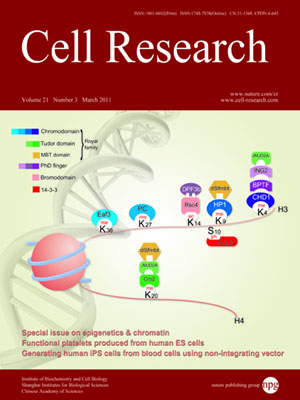Volume 21 Issue 3, March 2011: 518-529
ORIGINAL ARTICLES
Efficient human iPS cell derivation by a non-integrating plasmid from blood cells with unique epigenetic and gene expression signatures
Bin-Kuan Chou1,2,*, Prashant Mali1,3,*, Xiaosong Huang1,4,*, Zhaohui Ye1,4, Sarah N Dowey1,4, Linda MS Resar4, Chunlin Zou1,5, Y Alex Zhang5, Jay Tong6 and Linzhao Cheng1,2,4
1Stem Cell Program, Institute for Cell Engineering, The Johns Hopkins University School of Medicine, Baltimore, Maryland, USA
2Graduate Program in Cellular and Molecular Medicine, The Johns Hopkins University School of Medicine, Baltimore, Maryland, USA
3Graduate Program in Biomedical Engineering, The Johns Hopkins University School of Medicine, Baltimore, Maryland, USA
4Division of Hematology in Department of Medicine, The Johns Hopkins University School of Medicine, Baltimore, Maryland, USA
5Cell Therapy Center, Xuanwu Hospital and Capital Medical University, Beijing, China
6AllCells LLC, Emeryville, California, USA
Correspondence: Linzhao Cheng,(410-614-6958;)
ORIGINAL ARTICLE
Cell Research (2011): 518-529
© 2011 IBCB, SIBS, CAS All rights reserved 1001-0602/06 $ 30.00
www.nature.com/cr
Efficient human iPS cell derivation by a non-integrating plasmid from blood cells with unique epigenetic and gene expression signatures
Bin-Kuan Chou1,2,*, Prashant Mali1,3,*, Xiaosong Huang1,4,*, Zhaohui Ye1,4, Sarah N Dowey1,4, Linda MS Resar4, Chunlin Zou1,5, Y Alex Zhang5, Jay Tong6 and Linzhao Cheng1,2,4
1Stem Cell Program, Institute for Cell Engineering, The Johns Hopkins University School of Medicine, Baltimore, Maryland, USA
2Graduate Program in Cellular and Molecular Medicine, The Johns Hopkins University School of Medicine, Baltimore, Maryland, USA
3Graduate Program in Biomedical Engineering, The Johns Hopkins University School of Medicine, Baltimore, Maryland, USA
4Division of Hematology in Department of Medicine, The Johns Hopkins University School of Medicine, Baltimore, Maryland, USA
5Cell Therapy Center, Xuanwu Hospital and Capital Medical University, Beijing, China
6AllCells LLC, Emeryville, California, USA Correspondence: Linzhao Cheng,
The Johns Hopkins University School of Medicine,
Broadway Research Building,
Room 747, 733 N. Broadway, Baltimore, MD 21205
Tel: 410-614-6958; Fax: 443-287-5611
E-mail: lcheng@welch.jhu.edu
*These three authors contributed equally to this work.
Download as printable (PDF) file
Full Text (html)file
Search Medline for articles by:
Bin-Kuan Chou
To identify accessible and permissive human cell types for efficient derivation of induced pluripotent stem cells (iPSCs), we investigated epigenetic and gene expression signatures of multiple postnatal cell types such as fibroblasts and blood cells. Our analysis suggested that newborn cord blood (CB) and adult peripheral blood (PB) mononuclear cells (MNCs) display unique signatures that are closer to iPSCs and human embryonic stem cells (ESCs) than age-matched fibroblasts to iPSCs/ESCs, thus making blood MNCs an attractive cell choice for the generation of integration-free iPSCs. Using an improved EBNA1/OriP plasmid expressing 5 reprogramming factors, we demonstrated highly efficient reprogramming of briefly cultured blood MNCs. Within 14 days of one-time transfection by one plasmid, up to 1000 iPSC-like colonies per 2 million transfected CB MNCs were generated. The efficiency of deriving iPSCs from adult PB MNCs was approximately 50-fold lower, but could be enhanced by inclusion of a second EBNA1/OriP plasmid for transient expression of additional genes such as SV40 T antigen. The duration of obtaining bona fide iPSC colonies from adult PB MNCs was reduced to half (~14 days) as compared to adult fibroblastic cells (28–30 days). More than 9 human iPSC lines derived from PB or CB blood cells are extensively characterized, including those from PB MNCs of an adult patient with sickle cell disease. They lack V(D)J DNA rearrangements and vector DNA after expansion for 10–12 passages. This facile method of generating integration-free human iPSCs from blood MNCs will accelerate their use in both research and future clinical applications.
Cell Research (2011) 21:518-529. doi:10.1038/cr.2011.12; published online 18 January 2011
FULL TEXT | PDF
Browse 2252


